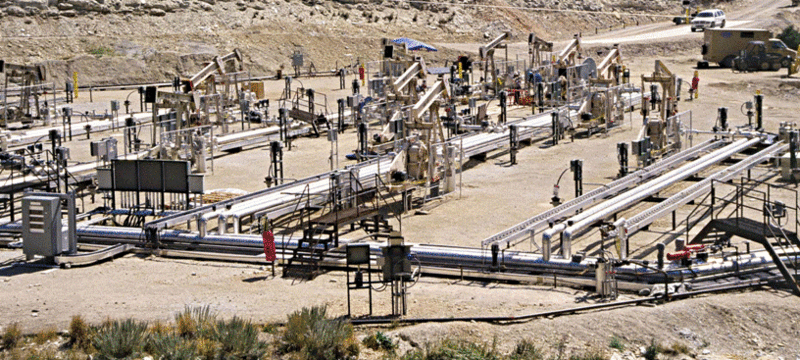
Is Russia Right About US Shale Energy?
By F. William Engdahl
6 November 2019
Image credits: U.S. Geological Survey Department of the Interior/USGS - This work is in the public domain in the United States because it is a work prepared by an officer or employee of the United States Government as part of that person’s official duties under the terms of Title 17, Chapter 1, Section 105 of the US Codehttps://bit.ly/2JVta16
In recent remarks to a Pennsylvania shale oil producers’ convention, US President Donald Trump, noting the spectacular growth in shale gas as well as shale oil over the past decade, remarked that unconventional shale energy had made “America the greatest energy superpower in the history of the world.” On first look the achievement has indeed been impressive. Since 2011 the USA surpassed Russia to become the world’s largest producer of natural gas. By 2018 USA had passed Russia and Saudi Arabia to become the world leading oil producer. It is all because of US unconventional shale oil and gas. But the success may be short-lived
.
The rise of shale energy and the favorable geological conditions in West Texas, North Dakota and elsewhere have given the US a clear geopolitical lever in world politics, not only in the Middle East or Venezuela policies. Also in the EU, where Russian gas remains the major supplier. Can the US continue to base policy on its leading role in gas and oil, or is this merely a blip due to end as suddenly as it appeared?
Just as a triumphant Trump was speaking in Pittsburg to the shale industry, Russian Energy Minister Novak pointed to recent slowing of shale oil output growth in key areas of the USA: “In the near future, if forecasts turn out correct, we will see a plateau in production.” He pointed to the significant reduction in shale oil drilling in recent months and predictions by Wall Street of a significant slowing of oil increases from shale in 2020. Prospects for US shale gas are far from positive as well, despite a current supply glut domestically. The LNG gas export terminal infrastructure, while it is increasing, is far from adequate to make the US a major supplier to the EU in competition to Russian gas. And money from Wall Street is drying up as well.
EU Defeat for Trump
The Trump Administration has staked much political effort on trying to convince the EU and other parts of the world to buy US shale gas instead of Russian conventional natural gas, arguing diversity of supply. That now looks unlikely to happen. Despite strong US pressure to cancel Europe’s NordStream2 gas pipeline from Russia across the Baltic Sea to Germany, which will double capacity and reduce Ukraine pipeline dependency significantly, the last EU barrier, Denmark, just announced it would approve the Gazprom route through its waters. The Danish decision, following months of Washington pressure, is a clear defeat for the Trump energy geopolitics strategy of substituting US shale gas as liquefied LNG for the Russian pipeline gas. Gazprom projects completion of the second line of the NordStream, doubling capacity, with gas deliveries to begin by early 2020.
As recently as July 2018 at a meeting with EU Commission President Juncker in Washington, Trump had announced that the European Union (EU) would soon be a “massive buyer” of US liquefied natural gas (LNG). That is yet to happen, though exports are up from a minimum level two years ago. US failure to block Russian gas deals a major blow to those hopes.
Aside from limited contracts between US LNG suppliers and Poland to date, there are few prospects now with EU approval of NordStream2 for major US LNG exports to EU markets in the next years.
Poland Turns to Norway
Even the one success for US shale Liquified Natural Gas export to the EU, namely Poland, is looking elsewhere for its non-Russian gas. Following signing of a gas contract with a US shale gas company in 2018, Poland has turned to Norwegian gas. The head of the Polish state gas company, Piotr Woźniak, just announced, “From 2022, via the Baltic Pipe, with a planned capacity of 10 billion cubic meters, we will import around 2.5 million cubic meters natural gas from our own extraction on the Norwegian Continental Shelf. We will buy the rest of the fuel from the Norwegian market.” So much for dreams of huge Polish gas purchases from the more costly US suppliers.
Export of US LNG depends on construction of costly infrastructure to liquefy the gas as well as special port facilities and tankers to load and ship the gas. Here the recent very low US domestic gas prices and high cost of investment have delayed completion of major export capacities. In 2018 production of natural gas in the US, much from shale fracking, had created a gas glut that is driving US gas prices to 25-year lows. This year gas production is 10% higher than last year.
The second largest US gas producer, Chesapeake Energy, is sharply curtaining investment in more gas and trying to sell assets and reduce debt. It discovered the prolific Haynesville field in 2008, but now is letting production in the northern Louisiana and east Texas field, once dubbed “the most revenue generative gas play in the US” decline because of low prices. They borrowed massively after 2010 when the Fed held interest rates at zero, to capitalize on the shale gas boom. Now with gas in abundance and Fed policies tighter, they and others are left with huge debts and falling gas prices.
They can go bankrupt and larger rivals like ExxonMobil can buy their gas reserves cheaply, but the economics of huge future investments in US LNG export to the EU or China are not bright. Washington’s trade war with China has led China to turn to Russia, Australia, Qatar and others for secure LNG imports just when US LNG exporters were expanding infrastructure. To retaliate against US tariffs, China imposed a 25% import tariff on US LNG, effectively killing US gas prospects. The reality is that US gas must face tough competition from several other producers in both the EU and Asia.
US Shale Oil Decline?
While the prospects for US shale gas to be a global dominant player are presently not great, the outlook for shale oil, by far the major focus of US shale drilling in recent years, is facing quite different problems. There has been a sharp cut in investment for shale oil projects as more Wall Street firms reduce risks in face of fears of a global economic downturn.
The output of US unconventional shale oil has been surprising to many over the past decade or so. US crude-oil production reached a record of 10.96 million barrels a day in 2018, according to the US Energy Information Administration. About 6.5 million barrels a day of crude oil, almost 60% of that total, came from shale resources and mostly from West Texas shale in the vast Permian Basin. But the pace of increase has been slowing significantly with some predicting a shale oil death spiral could ensue.
From the peak growth of late 2018 when oil from US shale increased by an annual rate of 1.8 million barrels, Rystad Energy estimates it will drop to half that this quarter. They note that the “significant expansion in well activity during 2017-2018,” came at the “cost of a steeper base decline.” So-called young wells produce large amounts of oil in their first few quarters, then see output rapidly decline.
With world oil prices stuck in the $50 range, despite geopolitical shocks in Venezuela, Iran, even Saudi Arabia, the economics of shale oil are facing stress. As most smaller shale companies still operate at a loss, if this does not change soon the rate of US shale oil bankruptcies could snowball.
The problem is that much of the US shale oil economics are opaque. Much investment into shale oil companies in recent years has been based on company estimates of increasing oil reserves. However the numbers are subject to a major conflict of interest. Since 2008 the Securities and Exchange Commission has allowed oil companies to use “proprietary methods” to determine reserves, that are not subject to disclosure. So long as production was booming and money plentiful, nobody minded much. Now that is changing. Recently the CEO of one of the largest companies in the Permian Basin, Scott Sheffield of Pioneer Natural Resources admitted that the oil industry is running out of Tier 1 acreage for shale oil. That is what are called “sweet spots,” where costs are low enough to be profitable. That is a major shift for Sheffield who only two years ago compared the Permian Basin shale reserves to Saudi Arabia.
What is likely at this juncture is further decline in production rates in the US shale oil sector and thus, US oil overall. The shale boom was known to be dependent on wells that reached peak output then depleted far faster than conventional wells. Technology helped mitigate the effects but only so far as money was cheap and oil prices rising. Since 2018 oil prices have fallen. In October 2018 West Texas Intermediate oil sold for over $75 a barrel. Today it is about $56 or dangerously near breakeven for most shale oil companies.
Shin Kim, at S&P Global Platts sees “the potential for shale to disappoint faster than the industry thinks.” She says, “Nothing else out there that can match US shale’s production growth rate of a million or a million and a half barrels of oil a day, and it’s a consistent level of growth.”
The geopolitical consequences of a rapid decline in US shale oil would have serious impact on US foreign policy options and, as US oilfield investment declines, also on the US economy, not good news for a Trump re-election. One ominous sign is the fact that while in earlier shale downturns shale oil frackers parked unused equipment waiting for a revival in demand, this time the equipment is being stripped down for parts or sold for scrap.
F. William Engdahl is strategic risk consultant and lecturer, he holds a degree in politics from Princeton University and is a best-selling author on oil and geopolitics, exclusively for the online magazine “New Eastern Outlook”
